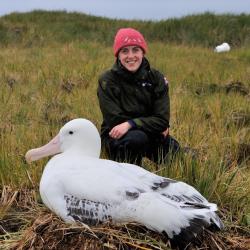Biography
I graduated in 2017 with a BA in Zoology and an MSci in Systems Biology from the University of Cambridge. My undergraduate research investigated foraging behaviour and senescence in wandering albatrosses, while during my masters course I developed my programming skills working on a spatial model of early modern human migration and demography.
From 2017 to 2021 I worked in the Marine Science Team at BirdLife International, a global conservation NGO, based in Cambridge, UK. My research focussed on analysing seabird tracking data to understand which areas of the ocean seabirds frequent, and integrating this with other data such as threats to species to inform our seabird conservation work. I worked with researchers and BirdLife Partner organisations around the world to manage and analyse our global datasets: the Seabird Tracking Database and the network of marine Important Bird and Biodiversity Areas.
In October 2021 I started a PhD based at British Antarctic Survey and the University of Cambridge, UK. I am using tracking and remote sensing data to understand the roles of habitat availability and preference in determining the structure and abundance of Southern Ocean seabird communities. My research is funded by NERC via the Cambridge Climate Life and Earth Doctoral Training Partnership. My PhD project is supervised by Prof. Andrea Manica at the University of Cambridge and Prof. Richard Phillips at the British Antarctic Survey.
Research
Understanding how species use and partition resources is crucial for understanding community structure. Southern Ocean seabirds provide an excellent case study for investigating species coexistence: many similar species breed at the same sites, but patterns in abundance and distribution vary, and tracking has revealed considerable habitat specialisation. My PhD research focusses on consistency in habitat use among populations, investigating the roles of habitat availability and preference in driving abundance and distributions of albatross and petrel species.
I analyse tracking data along with other available datasets to understand the intrinsic and extrinsic drivers of seabird distributions and foraging behaviour. As well as comparing populations, I am interested in how habitat preferences develop in early life, and how they change according to differing requirements and constraints across the breeding cycle. My research addresses fundamental questions in ecology, evolution and development of seabird foraging behaviour.
Publications
Carneiro, AP, EJ Pearmain, S Oppel, TA Clay, …, & MP Dias (2020). A framework for mapping the distribution of seabirds by integrating tracking, demography and phenology. Journal of Applied Ecology. DOI: 10.1111/1365-2664.13568
Dias, MP, R Martin, EJ Pearmain, IJ Burfield, C Small, RA Phillips, O Yates, B Lascelles, PG Borboroglu, & JP Croxall (2019). Threats to seabirds: A global assessment. Biological Conservation. DOI: 10.1016/j.biocon.2019.06.033
Clay, TA, EJ Pearmain, RA McGill, A Manica, & RA Phillips (2018). Age‑related variation in non‑breeding foraging behaviour and carry‑over effects on fitness in an extremely long‑lived bird. Functional Ecology. DOI: 10.1111/1365-2435.13120
For a full publication list, please see my Google Scholar page.

